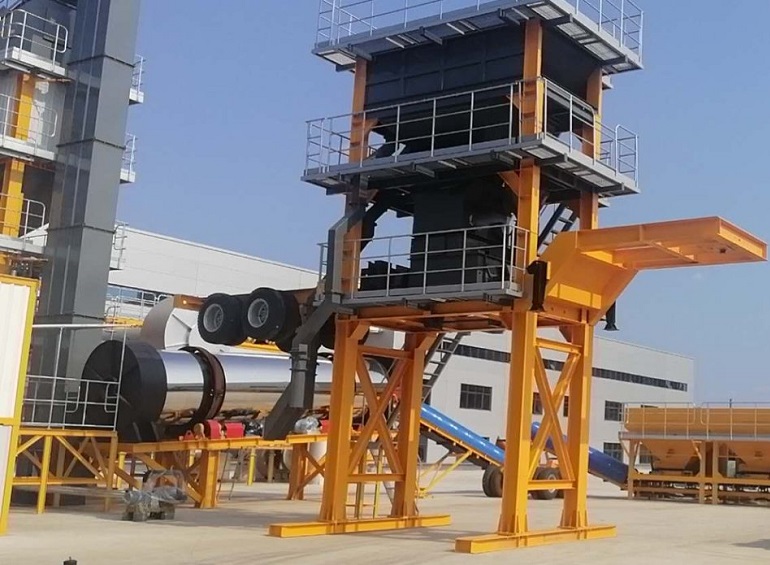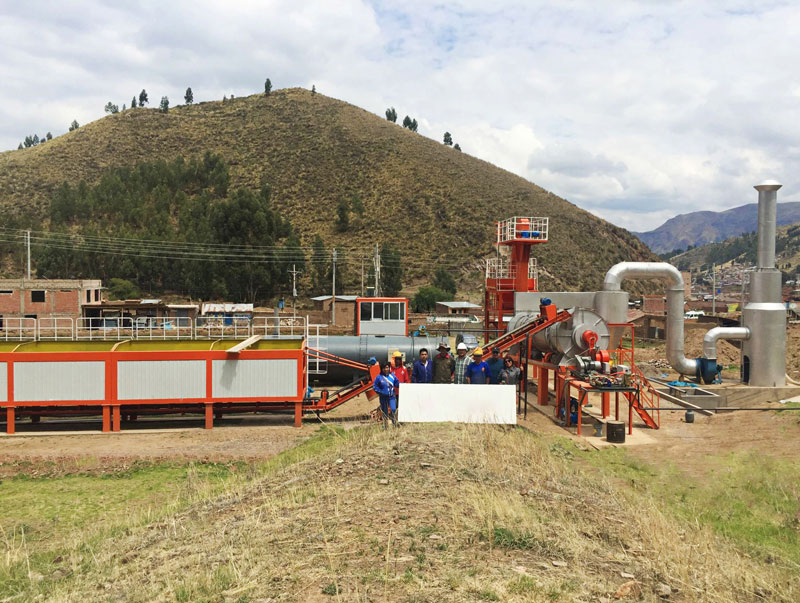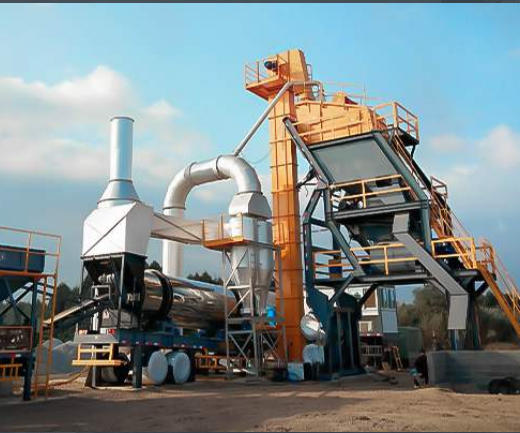How to treat the waste gas from the asphalt mixing plants ?
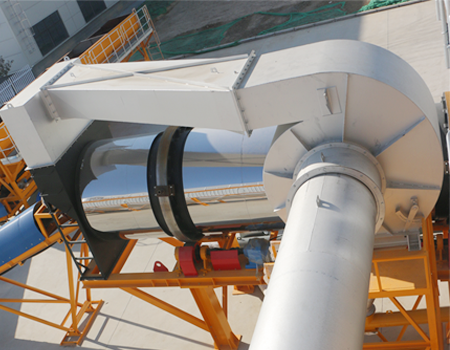
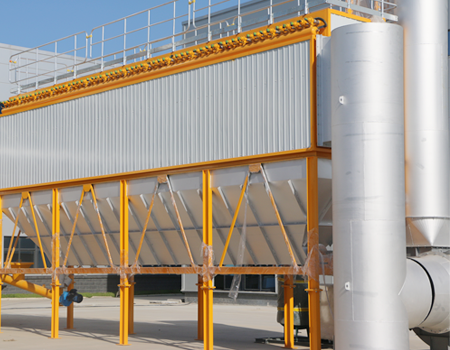
I. Waste gas sources:
The flue gas discharged from the stirring of the asphalt is purified by bag dust removal, dust-containing flue gas after the dust is removed.
Second, exhaust gas characteristics:
1. Exhaust gas composition:
The flue gas contains a variety of organic substances, including carbocyclic hydrocarbons, cyclic hydrocarbon derivatives, and other compounds (such as benzopyrene, benzoanthracene, carbazole, etc.). The particle size is mostly between 0.1 and 1.0 μm, the smallest is only 0.01 μm, and the largest is about 10.0 μm. The main way of harming human health is to attach to the dust below 8 um and suck it into the body through the respiratory tract. Therefore, it is necessary to purify and control the asphalt flue gas so that the emissions meet atmospheric environmental standards.
2. Harm to the human body
Asphalt and its smoke are irritating to the skin and mucous membranes, have phototoxicity and tumorigenic effects. The human body will feel dizzy, bloated, headache, chest tightness, fatigue, loss of appetite, etc. when inhaling the asphalt smoke, systemic symptoms and irritation symptoms of eyes, nose, and throat. 3. Smoke characteristics
1) Small particle size: Asphalt smoke mainly exists in the form of tar fine mist particles of 0.1 to 1.0um, and the smallest is only 0.01μm.
2) The flue gas temperature is generally high: the asphalt flue gas temperature is generally higher than 100 ° C;
3) There are hidden dangers of fire and explosion.
Third, commonly used processing technology:
There are many ways to treat asphalt flue gas, and the commonly used asphalt flue gas purification methods are as follows.
1. Mechanical separation method:
When the asphalt flue gas contains dust, spray steam or water mist into it to increase the diameter of the flue gas particles, and then separate the gas from the particles in the sedimentation chamber or cyclone to achieve the purpose of purifying the asphalt flue gas. Because the particle diameter of the dust is too small, even if it is increased by collision, it still cannot reach the appropriate particle diameter of cyclone dust collection, and the dust collection effect is very poor, so the mechanical separation method is rarely used.
2. Condensation method:
The condensing method is used as a supplementary method for the purification of asphalt flue gas, and is a treatment method used in conjunction with other purification methods (such as: adsorption, absorption, etc.). Asphalt flue gas can be condensed to increase the particle size of the mist particles in the flue gas, which is beneficial to the purification of asphalt flue gas.
3. Absorption and purification method:
Absorption and purification method, commonly known as washing method, is a commonly used industrial waste gas treatment method. It is a method for purifying the exhaust gas by using the mixed components of the exhaust gas with different solubility in the selected absorbent (gasoline, diesel, etc.), or a certain component reacts with the active component in the absorbent.
The absorption purification method is applied to the treatment of asphalt flue gas, that is, the gaseous pollutants in the flue gas (actually, tar fine particles of 0.1 to 1.0 μm) are transferred to the liquid phase (absorbent), thereby purifying the flue gas. the goal of. For the relatively small amount of asphalt flue gas treated by dry bag dust removal in asphalt concrete mixing plants, water is the most economical and effective absorbent. After the tar fine mist particles in the bitumen gas are adsorbed by water, they are basically insoluble in water and will not react to produce a large number of new compounds. Most of them will form oil slicks floating on the water surface, which can be collected after being accumulated to a certain extent and incorporated Used as fuel in coal combustion. After multiple cycles, the concentration of the emulsion in the water will increase, which will reduce the treatment effect.
4. Filtering method:
The filtration method is a method that uses a porous medium to collide with the tar fine mist particles in the asphalt flue gas to adsorb the tar fine mist particles in the flue gas, thereby purifying the asphalt flue gas. In principle, it should be a kind of adsorption method, which has been used in the domestic waterproof industry for more than 10 years. It is also the most widely used asphalt flue gas treatment method.
Bag filters are one of the commonly used methods. However, for asphalt flue gas purification, the filter bag needs to be oil-proof, waterproof, heat-resistant and corrosion-resistant. Although it has a high purification efficiency, it cannot filter soot below 0.5 microns.
5. Adsorption purification method:
Adsorption purification method is the operation of accumulating or condensing one or more components in a fluid (gas or liquid) mixture on the surface with a porous solid (adsorption filter material) to achieve the purpose of separation. The difference between the forces is divided into two types: physical adsorption and chemical adsorption.
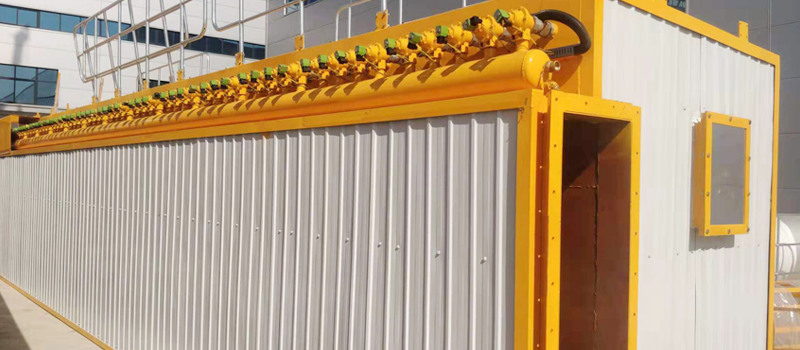
Adsorption purification is used for physical treatment of asphalt flue gas treatment. Physical adsorption is caused by the intermolecular gravity, which is often called "Vandervale force". It is a general term for directional force, induction force, and dispersion force. It is characterized in that no chemical interaction occurs between the adsorbent and the adsorbent, which is a reversible process, that is, adsorption and desorption. Physical adsorption is generally not affected by temperature, but the amount of adsorption decreases with increasing temperature. Therefore, the condensation treatment of asphalt flue gas before adsorption purification can improve the purification effect. Selecting the appropriate adsorption filter is one of the keys to the adsorption purification method. As an adsorption filter, it should generally have the following characteristics: it has a large adsorption capacity, that is, the adsorption filter should be a loose solid foam; it has good selectivity in order to achieve the purpose of purifying one or several pollutants; it has a good Regeneration characteristics and abrasion resistance, with adaptability to acid, alkali, water, high temperature.
The main equipment of the asphalt flue gas purification method is a fixed bed adsorber, which is generally a cylindrical vertical structure with a built-in grid or perforated plate on which filter material is placed. The asphalt flue gas passes through the container and passes through the filter material gap. It is discharged after adsorption or enters the next process. The design and calculation of fixed-bed adsorbers are mainly considered from the two aspects of adsorption equilibrium and adsorption rate. The factors affecting the adsorption equilibrium and adsorption rate of fixed-bed are mainly reflected in the size of the mass transfer zone, the shape of the transmission curve, Data on the time to reach the breaking point and the saturation of the filter media in the bed when the breaking point appears are more complicated.
6. Static capture method:
Because the specific resistance of asphalt is suitable. No corrosive effect on metal. After trapping, it is a liquid. The electrostatic trap method has a better effect in purifying asphalt fume.
7. Combustion method:
That is, the asphalt flue gas is directly introduced into a dedicated heating furnace for incineration, and after a certain period of high temperature incineration, the asphalt flue gas can be purified more thoroughly. This treatment is used more often in the treatment of the tail gas of the oxidized asphalt plant, but the equipment investment of this method is large and the operating cost is high. And has great security risks.
8. Low temperature plasma dust removal technology:
Low-temperature plasma technology, as an efficient and new type of dust removal technology, realizes the integration of dust removal, desulfurization, and denitration. The purification rate of smoke and dust can reach 98%, and the removal rate of organic volatile VOCs: ≥85%. Can collect ultra fine dust particles of 0.001 ~ 0.01μm class.



 RU
RU MM
MM AR
AR
